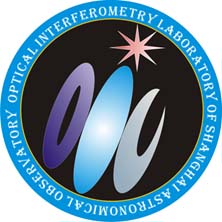High sensitivity and resolution are two foremost motivations for building optical telescopes since several centuries all along. These specifications are associated with aperture of telescopes, performance of instrumentations and atmospheric turbulence closely. To enlarge telescope aperture is a general valid method for scientists. A few of giant optical telescopes projects with 30~40 meters diameter and 2~5 thousands of tons weight are ongoing at present. Unfortunately, so large-scale size and heavy weight will bring overwhelming technological challenges to optics, mechanics and control design and manufacture of giant telescopes. Optical interferometer which is thought as a technique can break through aperture limit is developing subsequently. 2 or more small telescopes are configured as an array, and multiple beams are combined to achieve interferometric image with high angular resolution which is proportional with length of baselines (separation between sub-telescopes).
Now, scientists are more eager to see true images of AGN, Quasars and so on following with further study of galaxy formation and evolution in modern astrophysics. So-called Fizeau interferometry for direct imaging is becoming a highlight of future optical telescopes. Some giant astronomical optical interferometer projects such as VLTI, NPOI, and LBTI have being updated or constructed for the purpose of imaging by densifying pupils. In addition to celestial bodies, Optical aperture synthesis imaging technology, a kind of particular optical interferometry with multiple apertures, short baselines and sufficient spacial frequency also can be applied to measuring or imaging of artificial spacecrafts.
Our Fields

“OIL @ SHAO” is our team’s name. It is the abbreviation of “Optical Interferometry Laboratory of Shanghai Astronomical Observatory”. We have being involved in optical interferometry of astronomy since 2003. Our study focus on theoretical analysis, opto-mechanic scheme, and some key techniques (e.g. array configuration, co-phasing error sensing & alignment, multiple beam combining, interferometric image reconstruction and so on). Now, we have built a Y-type Fizeau interferometer test-bed in the lab. This test-bed consists of 3 independent Φ100mm telescope. We have carried out some experiments including sensing & alignment of co-phasing errors between sub-apertures by Pyramid Wavefront Sensor or fringe dispersion method, degrated image reconstruction, and etc. We are also interested in segment-mirror telescope, adaptive optics and other novel techniques of astronomical optics.
Team Members
Zhu Nenghong: Academician of the Chinese academy of engineering
Chen Xinyang: Ph.D, Senior Engineer, control & software, xychen@shao.ac.cn
Zhou Dan: Master, Senior Engineer, optics design, dzhou@shao.ac.cn
Zheng Lixin: Master, Engineer, optical sensing, zhenlixin@shao.ac.cn
Yan Zhaojun: Ph.D, Engineer, optical information processing, zhaojunyan@shao.ac.cn
Wang Chaoyan: Master, Engineer, optical sensing, superyan@shao.ac.cn
Li Kexin: Ph.D, senior Engineer, opto-mechanism design, likexin@shao.ac.cn
Zhang Congcong: Master, Engineer, mechanical design, zycium@shao.ac.cn
Ding Yuanyuan: Ph.D, Associate Professor, image processing, yuanyuand@shao.ac.cn